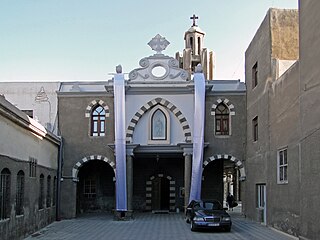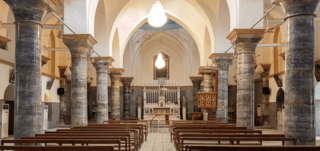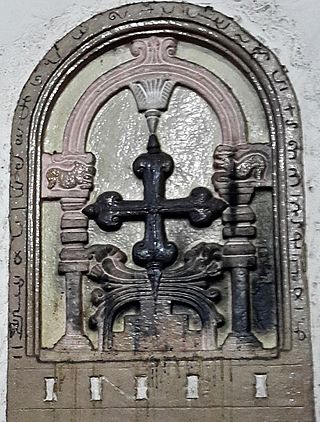
John Maron, was a Syriac monk, and the first Maronite Patriarch. He is revered as a saint by the Maronite Church and universal Catholic Church, and is commemorated on March 2. He died and was buried in Kfarhy near Batroun, in Lebanon, where a shrine is dedicated to him.

The Syriac Catholic Church is an Eastern Catholic Christian jurisdiction originating in the Levant that uses the West Syriac Rite liturgy and has many practices and rites in common with the Syriac Orthodox Church. Being one of the twenty-three Eastern Catholic Churches, the Syriac Catholic Church is a self-governed sui iuris particular church, while it is in full communion with the Holy See and with the entirety of the Catholic Church.
Jacob of Sarug, also called Mar Jacob, was one of the foremost Syriac poet-theologians, perhaps only second in stature to Ephrem the Syrian and equal to Narsai. Where his predecessor Ephrem is known as the 'Harp of the Holy Spirit', Jacob is the 'Flute of the Holy Spirit' in the Antiochene Syriac Christianity. He is best known for his prodigious corpus of more than seven-hundred verse homilies, or mêmrê, of which only 225 have thus far been edited and published.

The Syro-Malabar Catholic Church, is an Eastern Catholic Church based in Kerala, India. It is sui iuris (autonomous) particular Church in full communion with the Pope and the worldwide Catholic Church, including the Latin Church and the 22 other Eastern Catholic Churches, with self-governance under the Code of Canons of the Eastern Churches (CCEO). The Church is headed by the Major Archbishop of the Syro-Malabar, currently George Alencherry. The Syro-Malabar Synod of Bishops canonically convoked and presided over by the Major Archbishop constitutes the supreme authority of the Church. The Major Archiepiscopal Curia of the Church is based in Kakkanad, Kochi. Syro-Malabar is a prefix reflecting the church's use of the East Syriac Rite liturgy and origins in Malabar. The name has been in usage in official Vatican documents since the nineteenth century.

The Chaldean Catholic Church is an Eastern Catholic particular church in full communion with the Holy See and the rest of the Catholic Church, and is headed by the Chaldean Patriarchate. Employing in its liturgy the East Syriac Rite in the Syriac dialect of the Aramaic language, it is part of Syriac Christianity. Headquartered in the Cathedral of Our Lady of Sorrows, Baghdad, Iraq, since 1950, it is headed by the Catholicos-Patriarch Louis Raphaël I Sako. In 2010, it had a membership of 490,371, of whom 310,235 (63.27%) lived in the Middle East.

According to Eastern Christian tradition, Addai of Edessa or Thaddeus of Edessa was one of the seventy disciples of Jesus. He is possibly identical with Thaddaeus, one of the Twelve Apostles. From an early date his hagiography is filled with legends and fabrications. The saint himself may be entirely fictitious.

The Holy Qurbana, refers to the Eucharistic liturgy as celebrated in East Syriac Christianity and the liturgical books containing the rubrics for its celebration. Churches that celebrate this liturgy include various descendants of the Church of the East. East Syriac Christianity consists of an Edessan liturgical rite called the East Syriac Rite. The major anaphora of the East Syriac tradition is the Holy Qurbana of Saints Addai and Mari; Addai being a disciple of Thomas the Apostle and Mari being Addai's disciple. These churches are primarily based in the Middle East and India, with diasporic communities settled in the western world.

Alphabetical list of Eastern Christianity-related articles on English Wikipedia

The East Syriac Rite or East Syrian Rite, also called the Edessan Rite, Assyrian Rite, Persian Rite, Chaldean Rite, Nestorian Rite, Babylonian Rite or Syro-Oriental Rite, is an Eastern Christian liturgical rite that employs the Divine Liturgy of Saints Addai and Mari and the East Syriac dialect as its liturgical language. It is one of two main liturgical rites of Syriac Christianity, the other being the West Syriac Rite.
Eutychius of Alexandria was the Melkite Patriarch of Alexandria. He is known for being one of the first Christian Egyptian writers to use the Arabic language. His writings include the chronicle Nazm al-Jauhar, also known by its Latin title Eutychii Annales.
The Corpus Scriptorum Christianorum Orientalium is an important multilingual collection of Eastern Christian texts with over 600 volumes published since its foundation in 1903 by the Catholic University of Louvain in Belgium and the Catholic University of America in Washington, D.C. The present Secretary General is Andrea Schmidt of the University of Louvain (UCLouvain) in Louvain-la-Neuve.
The Festal Letters or Easter Letters are a series of annual letters by which the Bishops of Alexandria, in conformity with a decision of the First Council of Nicaea, announced the date on which Easter was to be celebrated. The council chose Alexandria because of its famous school of astronomy, and the date of Easter depends on the spring equinox and the phases of the moon.

The history of the Church of the East in India is dated to 52 AD by apocryphal sources and to the 9th century by the Quilon Syrian copper plates, the latter of which is considered the earliest reputable dating for Christians in the Indian subcontinent.
The Chronicle of 1234 is an anonymous West Syriac universal history from Creation until 1234. The unknown author was probably from Edessa. The Chronicle only survives in fragments, from which it is known to be divided into two parts: the first on ecclesiastical history, the second on secular. It was critically edited and translated by the French Orientalist Jean-Baptiste Chabot in 1920 and by Albert Abouna in 1974.

Mar Shimun XX Paulos served as the 118th Catholicos-Patriarch of the Assyrian Church of the East.

The Liturgy of Addai and Mari is the Eucharistic liturgy belonging to the East Syriac Rite and was historically used in the Church of the East of the Sasanian (Persian) Empire. This liturgy is traditionally attributed to Saint Addai and Saint Mari. It is currently in regular use in the Assyrian Church of the East of Iraq, the Ancient Church of the East of Iraq, the Syro-Malabar Church of India, and the Chaldean Catholic Church of Iraq. The latter two are Eastern Catholic churches in full communion with the Holy See of Rome.
André de Halleux (1929–1994) was a Belgian Franciscan, and professor at the University of Louvain at the Theological Faculty and at the Oriental Institute.
Mar Ishodad of Merv was a bishop of Hdatta during the Abbasid Caliphate and prominent theologian of the Church of the East, best known for his Commentaries on the Syriac Bible.
Holy Leaven, also known as Malka, is a powder added to the sacramental bread used in the Eucharist of both the Ancient Church of the East and the Assyrian Church of the East and historically in the Church of the East. Both churches hold the Holy Leaven to be one of their seven sacraments. The Syro-Malabar Church in India, which was historically a part of the Church of the East, also uses Holy Leaven to prepare sacramental bread in several churches whereas unleavened bread is also in use. There are two rituals associated with the Holy Leaven: its addition to sacramental bread before it is baked, and the annual renewal of the Holy Leaven itself.

The Chronicle of Arbela claims to record the early history of Christianity in the city which is now known as Erbil, Iraqi Kurdistan, but which was then Arbela, capital of Adiabene. First published in 1907, its age and historicity are disputed among scholars.










